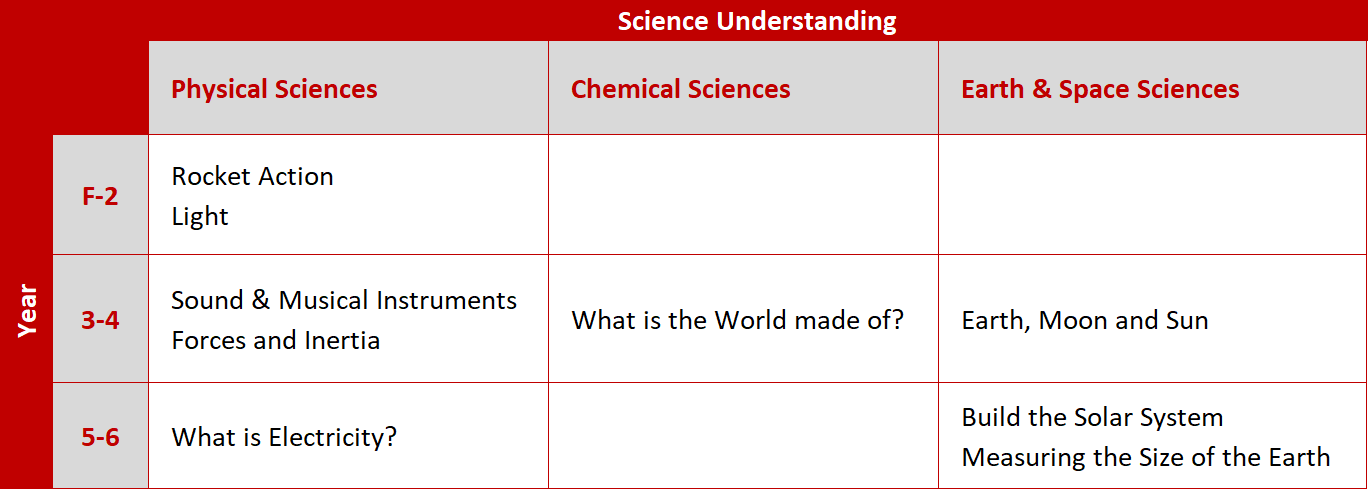Call us to arrange a school incursion for your students
Promote curiosity and build engagement with our school visits. The students perform experiments in our facilitator-led workshops that develop their understanding and help them grow. The activities are the pathway joining the textbook to the real world to teach the primary science curriculum. No preparation required, we bring all the equipment.

Scientific Inquiry
- Introduction to science (all grades)
- What is science?
- Using our senses to investigate scientifically.
- The scientific method is simple yet powerful – explained in a way that is accurate and wonderfully easy-to-grasp for even the youngest students.
Physical sciences
- Rocket action (F-2)
- Investigate the way different objects move.
- Introduce the concepts of push and pull.
- Understand how a rocket moves.
- Students build and fly their own (safe) rockets.
- Students accomplish learning goals ACSSU033 / VCSSU048.
- Light (F-2 and up)
- Where does light comes from?
- How do you sense light, how does the eye work?
- Mix light of different colours and notice what happens.
- Shine light onto and into different materials and observe how it behaves – refraction, reflection and absorption.
- Light is part of a wider electromagnetic spectrum that includes UV radiation, x-rays, microwaves and radio waves.
- Students accomplish learning goals ACSSU020 / VCSSU049.
- Forces and non-contact forces (3-4 and up)
- Forces, gravity and friction:
- Notice how objects react when undisturbed, pushed and pulled to uncover Galileo’s principle of inertia and Newton’s laws of motion.
- Drop, roll and bounce objects under gravity and notice how they behave.
- Test how different materials slide over each other to discover some slide easily and some don’t to understand friction.
- Electric and magnetic forces:
- Surprise and excite students when they levitate objects without touching them using electricity and magnetism.
- Discover electric and magnetic forces attract and repel
- Notice magnets attract some materials a lot (ferromagnetism) yet hardly affect others
- Realise magnetism can generate electric currents and electric currents can generate magnetism.
- Students make their own electric motor and grasp how it works with their understanding of electromagnetism.
- Students accomplish the ACSSU076 and VCSSU064 learning goals.
- Forces, gravity and friction:
- What is electricity? (5-6 and up)
- Students levitate objects without touching them to discover electric charge and electrostatic forces.
- Introduction to atoms and their parts - charged (and uncharged) particles.
- Show electrons can be made to flow using chemicals (batteries), light and solar cells, and moving magnets with metals.
- Learn that power stations use magnetism and spinning wheels with copper coils to generate electricity
- Students generate electricity and power a radio and lights with their own bicycle power station.
- Accomplishes learning goals ACSSU097, VCSSU081.
Chemical sciences
- What is the World made of? (3-4 and up)
- Recap on the concepts of solids, liquids and gases
- Demonstrates matter is made of atoms and molecules with stunning Physics and Chemistry demos.
- See that heat is just atoms and molecules jiggling.
- Introduce the elements and the periodic table.
- Split a compound into its elements – transform water in hydrogen and oxygen .
- React solutions to make carbon dioxide.
- Observe what happens to flames in hydrogen, oxygen and carbon dioxide.
- Students accomplish the VCSSU059, 076, 097, 098 / ACSSU077, 095.
Earth and Space science
- Earth, Sun and Moon (3-4)
- Notice Earth is moving and spinning which creates day, night and the seasons.
- Model the relative sizes of the Earth, Sun and Moon.
- Understand why the Moon has phases.
- Understand why there are eclipses.
- Learning goals VCSSU061, ACSSU048.
- Build the Solar System (5-6)
- Learn about Earth and the planets in the solar system.
- Students build a real scale model to grasp how big the planets are and the distance between them.
- Learning goals ACSSU078, VCSSU078.
Curriculum Enrichment
- Think BIG! Measure the size of the Earth (5-6 up)
- An enrichment session where students really measure the size of the Earth!
- Explore what is truly big and truly small.
- Teach the students how to notice the Earth’s surface is curved and not flat without going to space!
- Take the students on a journey ranging from the world of sub-atomic particles to the edge of the known universe.
- Sound and music (3-4 up)
- Students discover things are vibrating when there is a sound.
- Notice sounds comes from different sources including bars, pipes, strings, skins and plates.
- Long/large objects tend to vibrate with a low frequency and we hear a low pitch whilst short/smaller things vibrate with a high frequency and we hear a high pitch.
- Sound is a wave travelling in the air and our ears detect it.
- Some sounds are noise.
- Musical instruments are carefully crafted bars, pipes, strings, skins and plates.
- Learning goals VCSSU049, ACSSU078.